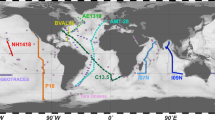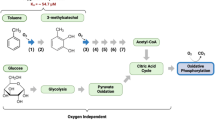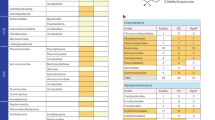Abstract
The bacterial terpenoid lipids known as hopanoids are fundamental tools for interpreting ancient microbial communities. Their degradation products, the hopanes, are found in sedimentary rocks throughout the geologic record. These compounds are presumed to be analogous to the sterols of eukaryotes, yet although the eukaryotic requirement for sterols is universal, hopanoid biosynthetic capacity is not ubiquitous among marine bacteria. Among the 9.8 million shotgun reads from the Sorcerer II Global Ocean Sampling (GOS) expedition, 148 contain putative coding sequence for bacterial squalene-hopene cyclases (SHCs). SHCs encoded by α-Proteobacteria potentially related to Rhodospirillaceae dominate these hits, especially in the open ocean and in tropical regions. Planctomycetes and β-Proteobacteria contribute more SHC-encoding sequences, and therefore presumably more hopanoid production, to coastal and temperate environments. Although sequences nominally related to α- and β-Proteobacteria outnumber other taxa in marine and coastal environments, there is large phylogenetic distance between GOS sequences and known species. Assuming that the environments sampled here are broadly representative of a wide range of surface ocean climates, depositional settings and temporal periods, the data suggest a fundamental function for Proteobacteria in the development of the geologic record of hopanes.
Similar content being viewed by others
Log in or create a free account to read this content
Gain free access to this article, as well as selected content from this journal and more on nature.com
or
References
Altschul SF, Madden TL, Schaffer AA, Zhang JH, Zhang Z, Miller W et al. (1997). Gapped BLAST and PSI-BLAST: a new generation of protein database search programs. Nucleic Acids Res 25: 3389–3402.
Bednarczyk A, Hernandez TC, Schaeffer P, Adam P, Talbot HM, Farrimond P et al. (2005). 32,35-Anhydrobacteriohopanetetrol: an unusual bacteriohopanepolyol widespread in recent and past environments. Org Geochem 36: 673–677.
Behrens A, Schaeffer P, Bernasconi S, Albrecht P . (1999). 17(E)-13 alpha(H)-Malabarica-14(27), 17,21-triene, an unexpected tricyclic hydrocarbon in sediments. 30: 379–383.
Blumenberg M, Kruger M, Nauhaus K, Talbot HM, Oppermann BI, Seifert R et al. (2006). Biosynthesis of hopanoids by sulfate-reducing bacteria (genus Desulfovibrio). Environ Microbiol 8: 1220–1227.
Bode HB, Zeggel B, Silakowski B, Wenzel SC, Reichenbach H, Muller R . (2003). Steroid biosynthesis in prokaryotes: identification of myxobacterial steroids and cloning of the first bacterial 2,3(S)-oxidosqualene cyclase from the myxobacterium Stigmatella aurantiaca. Mol Microbiol 47: 471–481.
Bosak T, Losick RM, Pearson A (2008). A polycyclic terpenoid that alleviates oxidative stress. Proc Natl Acad Sci USA 105: 6725–6729.
Brocks JJ, Logan GA, Buick R, Summons RE . (1999). Archean molecular fossils and the early rise of eukaryotes. Science 285: 1033–1036.
Brocks JJ, Love GD, Summons RE, Knoll AH, Logan GA, Bowden SA . (2005). Biomarker evidence for green and purple sulphur bacteria in a stratified Palaeoproterozoic sea. Nature 437: 866–870.
Capone DG, Zehr JP, Paerl HW, Bergman B, Carpenter EJ . (1997). Trichodesmium, a globally significant marine cyanobacterium. Science 276: 1221–1229.
Coolen MJL, Muyzer G, Rijpstra WIC, Schouten S, Volkman JK, Damste JSS . (2004). Combined DNA and lipid analyses of sediments reveal changes in Holocene haptophyte and diatom populations in an Antarctic lake. Earth Planetary Sci Lett 223: 225–239.
Coolen MJL, Volkman JK, Abbas B, Muyzer G, Schouten S, Damste JSS . (2007). Identification of organic matter sources in sulfidic late Holocene Antarctic fjord sediments from fossil rDNA sequence analysis. Paleoceanography 22: PA2211, 10.1029/2006PA001309.
Damste JSS, Muyzer G, Abbas B, Rampen SW, Masse G, Allard WG et al. (2004a). The rise of the rhizosolenid diatoms. Science 304: 584–587.
Damste JSS, Rijpstra WIC, Schouten S, Fuerst JA, Jetten MSM, Strous M . (2004b). The occurrence of hopanoids in planctomycetes: implications for the sedimentary biomarker record. Org Geochem 35: 561–566.
DeLong EF, Karl DM . (2005). Genomic perspectives in microbial oceanography. Nature 437: 336–342.
Dutkiewicz A, Volk H, George SC, Ridley J, Buick R . (2006). Biomarkers from Huronian oil-bearing fluid inclusions: an uncontaminated record of life before the Great Oxidation Event. Geology 34: 437–440.
Elvert M, Suess E, Greinert J, Whiticar MJ . (2000). Archaea mediating anaerobic methane oxidation in deep-sea sediments at cold seeps of the eastern Aleutian subduction zone. Org Geochem 31: 1175–1187.
Feil C, Sussmuth R, Jung G, Poralla K . (1996). Site-directed mutagenesis of putative active-site residues in squalene-hopene cyclase. Eur J Biochem 242: 51–55.
Fischer WW, Pearson A . (2007). Hypotheses for the origin and early evolution of triterpenoid cyclases. Geobiology 5: 19–34.
Fischer WW, Summons RE, Pearson A . (2005). Targeted genomic detection of biosynthetic pathways: Anaerobic production of hopanoid biomarkers by a common sedimentary microbe. Geobiology 3: 33–40.
Forster HJ, Biemann K, Haigh WG, Tattrie NH, Colvin JR . (1973). Structure of novel C35 pentacyclic terpenes from Acetobacter xylinium. Biochem J 135: 133–143.
Guindon S, Gascuel O . (2003). A simple, fast, and accurate algorithm to estimate large phylogenies by maximum likelihood. Syst Biol 52: 696–704.
Hartner T, Straub KL, Kannenberg E . (2005). Occurrence of hopanoid lipids in anaerobic Geobacter species. Fems Microbiol Lett 243: 59–64.
Hinrichs KU . (2001). A molecular recorder of methane hydrate destabilization. Geochem Geophys Geosyst 2: art. no.-2000GC000118.
Hinrichs KU, Hayes JM, Sylva SP, Brewer PG, DeLong EF . (1999). Methane-consuming archaebacteria in marine sediments. Nature 398: 802–805.
Hoshino T, Sato T . (2002). Squalene-hopene cyclase: catalytic mechanism and substrate recognition. Chem Commun, 4: 291–301.
Hugenholtz P, Pace NR . (1996). Identifying microbial diversity in the natural environment: a molecular phylogenetic approach. Trends Biotechnol 14: 190–197.
Mahenthiralingam E, Baldwin A, Drevinek P, Vanlaere E, Vandamme P, LiPuma JJ et al. (2006). Multilocus sequence typing breathes life into a microbial metagenome. PLoS ONE 1: e17.
Mallory FB, Conner RL, Landrey JR, Zander JM, Greig JB, Caspi E . (1968). Biosynthesis of tetrahymanol from (4R)-[4-3H-2-14C]mevalonic acid. J Am Chem Soc 90: 3564.
Ourisson G, Rohmer M, Poralla K . (1987). Prokaryotic hopanoids and other polyterpenoid sterol surrogates. Annu Rev Microbiol 41: 301–333.
Pancost RD, Damste JSS, de Lint S, van der Maarel M, Gottschal JC, Medinaut Shipboard Sci P . (2000). Biomarker evidence for widespread anaerobic methane oxidation in Mediterranean sediments by a consortium of methanogenic archaea and bacteria. Appl Environ Microbiol 66: 1126–1132.
Pearson A, Budin M, Brocks JJ . (2003). Phylogenetic biochemical evidence for sterol synthesis in the bacterium Gemmata obsuriglobus. Proc Natl Acad Sci USA 100: 15352–15357.
Pearson A, Page SRF, Jorgenson TL, Fischer WW, Higgins MB . (2007). Novel hopanoid cyclases from the environment. Environ Microbiol 9: 2175–2188.
Pearson A, Leavitt WD, Saenz JP, Summons RE, Tam CM, Close HG (2008). Diversity of hopanoids and squalene-hopene cyclases across a tropical land-sea gradient. Environ Microbiol (in press). doi:10.1111/j.1462-2920.2008.01817.x
Perzl M, Muller P, Poralla K, Kannenberg EL . (1997). Squalene-hopene cyclase from Bradyrhizobium japonicum: cloning, expression, sequence analysis and comparison to other triterpenoid cyclases. Microbiology (UK) 143: 1235–1242.
Rappe MS, Connon SA, Vergin KL, Giovannoni SJ . (2002). Cultivation of the ubiquitous SAR11 marine bacterioplankton clade. Nature 418: 630–633.
Rasmussen B, Fletcher IR, Brocks JJ, Kilburn MR (2008). Reassessing the first appearance of eukaryotes and cyanobacteria. Nature 455:1101–1104.
Rocap G, Larimer FW, Lamerdin J, Malfatti S, Chain P, Ahlgren NA et al. (2003). Genome divergence in two Prochlorococcus ecotypes reflects oceanic niche differentiation. Nature 424: 1042–1047.
Rohmer M, Bouviernave P, Ourisson G . (1984). Distribution of hopanoid triterpenes in prokaryotes. J Gen Microbiol 130: 1137–1150.
Rohmer M, Ourisson G . (1976). Structure of bacteriohopanetetrols from Acetobacter xylinium. Tetrahedron Lett, 40: 3633–3636.
Rusch DB, Halpern AL, Sutton G, Heidelberg KB, Williamson S, Yooseph S et al. (2007). The Sorcerer II Global Ocean Sampling expedition: Northwest Atlantic through Eastern Tropical Pacific. PLoS Biol 5: 398–431.
Schulz-Gasch T, Stahl M . (2003). Mechanistic insights into oxidosqualene cyclizations through homology modeling. J Comput Chem 24: 741–753.
Sogin ML, Morrison HG, Huber JA, Mark Welch D, Huse SM, Neal PR et al. (2006). Microbial diversity in the deep sea and the underexplored ‘rare biosphere’. Proc Natl Acad Sci USA 103: 12115–12120.
Stanier RY, Palleron NJ, Doudorof M . (1966). Aerobic pseudomonads—a taxonomic study. J Gen Microbiol 43: 159–271.
Stepanauskas R, Sieracki ME . (2007). Matching phylogeny and metabolism in the uncultured marine bacteria, one cell at a time. Proc Natl Acad Sci USA 104: 9052–9057.
Sugden MA, Talbot HM, Farrimond P . (2005). Flash pyrolysis—a rapid method for screening bacterial species for the presence of bacteriohopanepolyols. Org Geochem 36: 975–979.
Summons RE, Bradley AS, Jahnke LL, Waldbauer JR . (2006). Steroids, triterpenoids and molecular oxygen. Philos Trans R Soc B-Biol Sci 361: 951–968.
Summons RE, Jahnke LL, Hope JM, Logan GA . (1999). 2-Methylhopanoids as biomarkers for cyanobacterial oxygenic photosynthesis. Nature 400: 554–557.
Talbot HM, Rohmer M, Farrimond P . (2007a). Rapid structural elucidation of composite bacterial hopanoids by atmospheric pressure chemical ionisation liquid chromatography/ion trap mass spectrometry. Rapid Commun Mass Spectrom 21: 880–892.
Talbot HM, Rohmer M, Farrimond P . (2007b). Structural characterisation of unsaturated bacterial hopanoids by atmospheric pressure chemical ionisation liquid chromatography/ion trap mass spectrometry. Rapid Commun Mass Spectrom 21: 1613–1622.
Talbot HM, Squier AH, Keely BJ, Farrimond P . (2003a). Atmospheric pressure chemical ionisation reversed-phase liquid chromatography/ion trap mass spectrometry of intact bacteriohopanepolyols. Rapid Commun Mass Spectrom 17: 728–737.
Talbot HM, Summons R, Jahnke L, Farrimond P . (2003b). Characteristic fragmentation of bacteriohopanepolyols during atmospheric pressure chemical ionisation liquid chromatography/ion trap mass spectrometry. Rapid Commun Mass Spectrom 17: 2788–2796.
Talbot HM, Summons RE, Jahnke LL, Cockell CS, Rohmer M, Farrimond P . (2008). Cyanobacterial bacteriohopanepolyol signatures from cultures and natural environmental settings. Org Geochem 39: 232–263.
Talbot HM, Watson DF, Murrell JC, Carter JF, Farrimond P . (2001). Analysis of intact bacteriohopanepolyols from methanotrophic bacteria by reversed-phase high-performance liquid chromatography-atmospheric pressure chemical ionisation mass spectrometry. J Chromatogr A 921: 175–185.
Talbot HM, Watson DF, Pearson EJ, Farrimond P . (2003c). Diverse biohopanoid compositions of non-marine sediments. Org Geochem 34: 1353–1371.
Thiel V, Heim C, Arp G, Hahmann U, Sjovall P, Lausmaa J . (2007). Biomarkers at the microscopic range: ToF-SIMS molecular imaging of Archaea-derived lipids in a microbial mat. Geobiology 5: 413–421.
Thiel V, Peckmann J, Richnow HH, Luth U, Reitner J, Michaelis W . (2001). Molecular signals for anaerobic methane oxidation in Black Sea seep carbonates and a microbial mat. Mar Chem 73: 97–112.
Thoma R, Schulz-Gasch T, D’Arcy B, Benz J, Aebi J, Dehmlow H et al. (2004). Insight into steroid scaffold formation from the structure of human oxidosqualene cyclase. Nature 432: 118–122.
Thompson JD, Gibson TJ, Plewniak F, Jeanmougin F, Higgins DG . (1997). The CLUSTAL_X windows interface: flexible strategies for multiple sequence alignment aided by quality analysis tools. Nucleic Acids Res 25: 4876–4882.
Tippelt A, Jahnke L, Poralla K . (1998). Squalene-hopene cyclase from Methylococcus capsulatus (Bath): a bacterium producing hopanoids and steroids. Biochim Biophys Acta Lipids Lipid Metab 1391: 223–232.
Venter JC, Remington K, Heidelberg JF, Halpern AL, Rusch D, Eisen JA et al. (2004). Environmental genome shotgun sequencing of the Sargasso Sea. Science 304: 66–74.
Wakeham SG, Amann R, Freeman KH, Hopmans EC, Jorgensen BB, Putnam IF et al. (2007). Microbial ecology of the stratified water column of the Black Sea as revealed by a comprehensive biomarker study. Org Geochem 38: 2070–2097.
Wendt KU, Feil C, Lenhart A, Poralla K, Schulz GE . (1997). Crystallization and preliminary x-ray crystallographic analysis of squalene-hopene cyclase from Alicyclobacillus acidocaldarius. Protein Sci 6: 722–724.
Wendt KU, Schulz GE, Corey EJ, Liu DR . (2000). Enzyme mechanisms for polycyclic triterpene formation. Angew Chem Int Ed 39: 2812–2833.
Woodward RB, Bloch K . (1953). The cyclization of squalene in cholesterol synthesis. J Am Chem Soc 75: 2023–2024.
Yooseph S, Sutton G, Rusch DB, Halpern AL, Williamson SJ, Remington K et al. (2007). The Sorcerer II Global Ocean Sampling expedition: expanding the universe of protein families. PLoS Biol 5: 432–466.
Zehr JP, Bench SR, Mondragon EA, McCarren J, DeLong EF . (2007). Low genomic diversity in tropical oceanic N-2-fixing cyanobacteria. Proc Natl Acad Sci USA 104: 17807–17812.
Zehr JP, Waterbury JB, Turner PJ, Montoya JP, Omoregie E, Steward GF et al. (2001). Unicellular cyanobacteria fix N-2 in the subtropical North Pacific Ocean. Nature 412: 635–638.
Zhang K, Martiny AC, Reppas NB, Barry KW, Malek J, Chisholm SW et al. (2006). Sequencing genomes from single cells by polymerase cloning. Nat Biotechnol 24: 680–686.
Zundel M, Rohmer M . (1985a). Prokaryotic triterpenoids. 1. 3-beta-methylhopanoids from Acetobacter species and Methylococcus capsulatus. Eur J Biochem 150: 23–27.
Zundel M, Rohmer M . (1985b). Prokaryotic triterpenoids. 3. The biosynthesis of 2-beta-methylhopanoids and 3-beta-methylhopanoids of Methylobacterium organophilum and Acetobacter pasteurianus spp. pasteurianus. Eur J Biochem 150: 35–39.
Acknowledgements
We thank Jan DeLeeuw for coining the term ‘lipidomics’ and members of the Pearson lab for helpful discussions. We acknowledge the Department of Energy (DOE), Office of Science, and Office of Biological and Environmental Research (DE-FG02-02ER63453), the Gordon and Betty Moore Foundation, and the J Craig Venter Science Foundation for funding to undertake this study. We gratefully acknowledge the governments of the countries of origin for the GOS samples: Canada, USA, United Kingdom, Mexico, Honduras, Panama, Costa Rica, Ecuador, French Polynesia, Australia, Seychelles, Madagascar and Tanzania. Genomic sequences from NCBI are available in the public domain courtesy of JGI (http://www.jgi.doe.gov/) and the J Craig Venter Institute. Special thanks are due to Marv Frasier, Saul Kravitz and the CAMERA team for their suggestions in support of the Advanced Reference Viewer. This work was supported by grants from the NSF and David and Lucille Packard Foundation (to AP).
Author information
Authors and Affiliations
Corresponding author
Additional information
Supplementary Information accompanies the paper on The ISME Journal website (http://www.nature.com/ismej)
Supplementary information
Rights and permissions
About this article
Cite this article
Pearson, A., Rusch, D. Distribution of microbial terpenoid lipid cyclases in the global ocean metagenome. ISME J 3, 352–363 (2009). https://doi.org/10.1038/ismej.2008.116
Received:
Accepted:
Published:
Issue date:
DOI: https://doi.org/10.1038/ismej.2008.116
Keywords
This article is cited by
-
Biosynthetic gene cluster profiling from North Java Sea Virgibacillus salarius reveals hidden potential metabolites
Scientific Reports (2023)
-
Distribution and Abundance of Hopanoid Producers in Low-Oxygen Environments of the Eastern Pacific Ocean
Microbial Ecology (2016)
-
Diverse capacity for 2-methylhopanoid production correlates with a specific ecological niche
The ISME Journal (2014)
-
Molecular biologic techniques applied to the microbial prospecting of oil and gas in the Ban 876 gas and oil field in China
Applied Microbiology and Biotechnology (2010)



